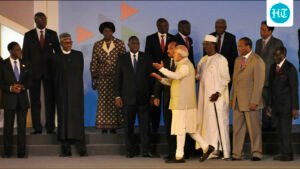
When I set out to write a book about India’s International Relations, I Did Not NECESSARILY Appreciate the Centrality of the Role of Technology. But in setting out the Basis of India’s International Relations – Past, Present, and Future – In Vishwa Shastra: India and the WorldI could not escape consider the critical role that Technology has been played, and continues to play, in the country’s internet engine.

Through History, Technological Developments have Shaped Competition and Cooperation Between Countries. In India’s case, it can be traced back to the spread of written, Agricultural, and Metallurgical Techniques in Pre-Historic and Ancient Times. At Various Points, India was a Regional Leader in Certain Technologies, Including Mathematics, Stone Masonry, and Seafaring Technologies. The spread of technology around what we might now call Import of Gunpowder and Paper-Making Techniques. The circulation of technology also took some unexpected turns, such as the difference of certain gunsmithing techniques from from west asia to India and from there to europe.
But, as a newly independent nation after 1947, Mastering Critical Technologies Assume A New Urgen. It explains India’s efforts at Reaching out to Several Partners in the Advanced Industrial World in its Early Years. With the US, India Sought Assistant in Dam Building and Water Management, Notable Through the Damodar Valley Corporation. With the Uk and the Commonwealth, India Participated in the Colombo Plan, which contributed significantly to Agricultural, Medical, and Urban Development. With West Germany, India Sought Defense and Aerospace Design, Resulting in-Among other things-Its first indigenous fighter jet, the HF-24 marut. After 1953, India also received received financial and technical assistance from the soviet union, resulting in the Bhilai Steel Plant in Present-Day Chhattisgarh, and Later the License Products of TRANSED Defense Products and Fighter aircraft.
India’s ability to work with a variety of partners contributed to some notable technological successes during the early years of the cold war. The first five Indian Institutes of Technology (IITS), Benefited Considerable from Assistant from the US, Ussr, United Nations, The UK, and West Germany, Including the Provision of Initial Labb Equipment. Just as dramatically, the green revolution benefited from public and private us and multilateral initiatives to introduce high-yield varieties of wheat, helping make India agriculturally Self-Suficient. Another area of initial success Raw Materials. In Fact, India Boasted An Undisputed Leadership Position in the Developing World when it came to Civilian Nuclear Technologies.
There was also some meaningful technological successes after Economic Liberalization and the End of the Cold War in 1991. Many domestic initiatives benefited from International Assistant Assistant AssistantSE to Advance Objectives, including Drastic Reductions in Communicable Diseases and the Development of a Pharmaceutical Industry. The Indian Telecommunications Revolution, While Mired in Scandals and Poor Infrastructure in the Initial Years, Took Off Afzle Foreign Venndors Agreed to Adapt their business models for the Indian market. The software and outsourcing boom of the late 1990s and early 2000s was the product of investments in human talent; Policy changes that slashed duties, subsidized broadband, and created single-window cleanses; And heightened global demand. Another clear manifestation was the delhi metro which, after 1995, Benefited from Financing, Imports, Systems, Technical Assistant, and Training from Japan, South Korea, Germany, Canada, Canada, The Us, The UK, Hong Kong.
Yet India’s Quest for Technology was not Always Sustained or Consistent. The country continued to lag in many important areas, include electronic and automotive manufacturing, defense production, and nuclear energy. It is Worth Considering What Factors Held India Back. Perhaps the most important was adverse politics, ideological hang-ups, and strong vested interesrs from public and private sector parties eager to preserve their power and monopoly. Second, in an era of Sharper Resource Constraints, Including Foreign Exchange Reserve, India Grew Accountmed to Cheap License Production – which included atrochantic Assistance but without the Necessary Technological Transfers. One Consequence was that India Could Rarely Take Advantage of its Immense Scale. Third, paradoxically, India Lacked Sufficient State Control of Production and Labor that Characterized Economies Such as the Soviet Union and Allowed Them to Makes in Critical Sectors. Finally, India often Had to Reconcile Foreign Dependencies with Strategic Autonomy, Particularly when it came to nuclear weapons, which contributed to an adverses Denials.
These limitations have slowly been overcome. Over the past two decades, successive governments have endeavoured to diversify India’s partnerships with advanced economies, Reduce Export Controls, Offer More AtRACTVE TERMSS For Technological indigenization, improvement processes, and Increase Financial Outlays. Efforts are also underway to Clarify Specifications, Alignments, and Processes when it come to procurements. In Civilian Sector Such as Semiconductor, Telecommunications, Electronics, Space, Biotechnology, And Other Nascent Technologies, India has been after Programmes, and regulatory and customs changes to encourage indigenization efforts. In addition, Foreign Partnerships that enable Investment, Market Access, Coordinated Standards, and Policy Alignment Remain Important.
Today’s Technological Priorities are Apparent. They include computational hardware, digital technologies, infrastructure, cleaner and more Efficient Energy Systems, Transportation, Health and Biotechnology, and Defeense and Aerospace. All Have Important Strategic and Economic Implications, as well as the potential to generate growth, jobs, and expenses. Defense Efforts Today Focus on Aircraft Components and Engines, Missile Systems, Drones and Countter-United Aerial Systems (Cuas), Cuas, Armoured Vehicles, Armoured VEHICles, Survelance and Radars Maintenance, Repair, and Overhaul (MRO) Facilites. Extra Efforts will have to be made in shipbuilding, particularly large hulls, for both defense and commercial platforms. To these ends, India has outlined new regulations in defense, artificial intelligence, space, drones, and geospatial data; Created nodal agencies for semiconductor, quantum technologies, and green hydrogen; Entred into a variety of agreements and mechanisms with foreign partners for investment, standard, technology transfers, market access, training, and support chain second.
While Considerable Progress has been made, it is worth reflecting on past experiences. Why did India successed – sometimes overcoming great adversity – in area such as space, necessary, public transportation, public health, and telecommunications, but struggle in aRAS of Defense, Electronics Assembly, Semiconductor, and Nuclear Industries Despite Apparent Head-STARTS? How can the mistakes of the past be reepeated when it comes to artificial intelligence or quantum technologies? These are worth considering as India makes another set of big bets on emerging technology in an increasingly competitive and contested world.
Dhruva jaishankar is executive director, orf america. The views expressed are personal







